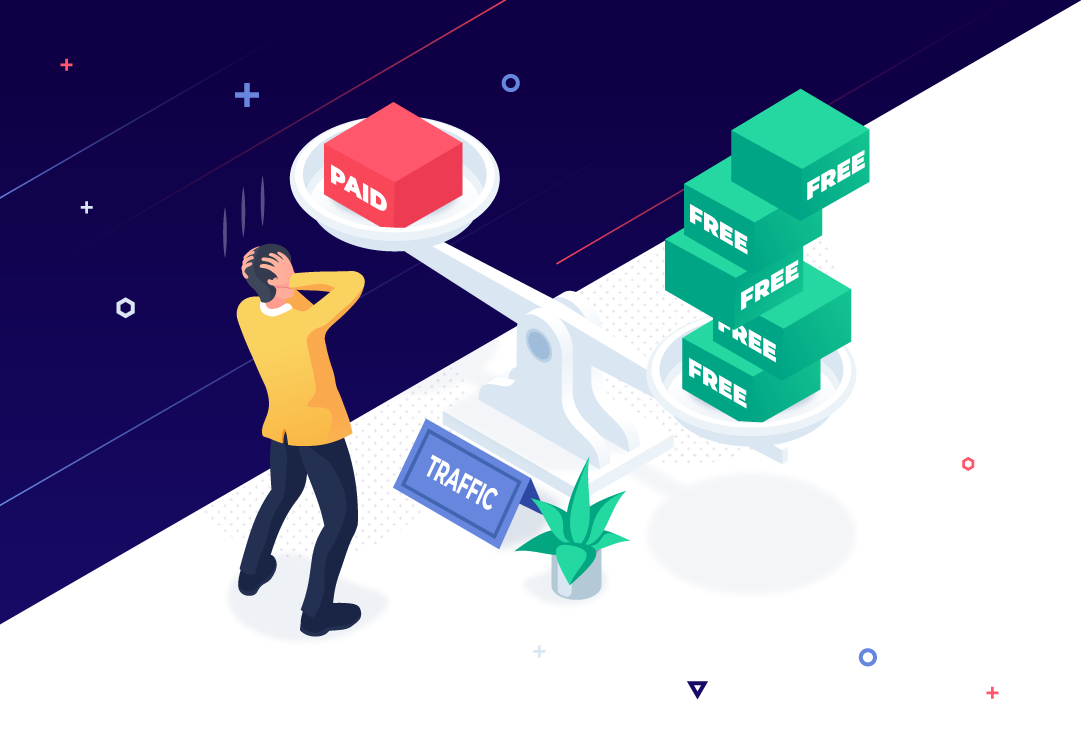When serving everyone costs more than you think
In March 2019, Facebook suffered a 14-hour outage that cost the company nearly $90 million in lost revenue. Whilst the immediate cause was technical failure, the underlying issue reveals something more fundamental about modern web infrastructure: the assumption that all traffic deserves equal treatment. For businesses operating under this assumption, the costs extend far beyond temporary downtime. Every day, companies spend thousands of pounds serving visitors who will never convert, never engage, and in many cases, aren’t even human. The practice of treating all web traffic equally might seem democratic, but the financial reality tells a different story.
The true cost of infrastructure
When businesses calculate their operational efficiency, they rarely account for the full infrastructure costs of handling low-quality traffic. Web servers, content delivery networks, and database queries all consume resources whether the visitor is a potential customer or an automated bot. Recent industry data suggests that maintaining the infrastructure to serve peak traffic costs enterprises an average of $14,056 per minute when systems become overwhelmed. For smaller businesses, the figures remain substantial, with costs ranging from $137 to $427 per minute even for modest operations.
The problem compounds during what should be commercially valuable moments. When a marketing campaign drives traffic to your site, the server capacity you’ve allocated must accommodate both genuine customers and whatever automated systems happen to arrive simultaneously. Research from 2024 indicates that bad bots alone account for 39% of all internet traffic, with this proportion rising dramatically during high-value sales events. The bandwidth costs and server utilisation required to handle this flood of worthless requests represents pure waste, yet most businesses continue to provision infrastructure as though all visitors merit equal resource allocation.
Consider the hidden expenses in your technology stack. Every database query triggered by a bot checking inventory consumes processing power. Every API call from an automated system uses the same network resources as a genuine customer’s purchase request. Cloud computing bills don’t distinguish between valuable and valueless traffic—you pay for the resource allocation regardless. One 2023 analysis found that businesses lose approximately 20 to 30% of their advertising spend to click fraud without realising it, but these figures don’t capture the broader infrastructure burden of serving traffic that arrives through legitimate channels yet serves no commercial purpose.
Analytics distortion and marketing waste
The operational efficiency problems extend well beyond infrastructure. Modern businesses make critical decisions based on web analytics, yet these systems struggle to distinguish between human behaviour and increasingly sophisticated automated traffic. When 22% of all digital advertising spend—approximately $84 billion in 2023 alone—is lost to ad fraud, the immediate financial impact is obvious. Less apparent is how polluted data undermines every subsequent marketing decision.
Marketing teams allocate budgets based on traffic patterns, conversion rates, and user engagement metrics. When bots inflate these figures, the resulting decisions become detached from commercial reality. A campaign might show impressive click-through rates whilst generating no actual business because the traffic quality is fundamentally compromised. Website performance metrics become meaningless when a significant portion of your “engaged users” are automated programmes designed to mimic human behaviour patterns. The cost per visitor calculation becomes fiction when you cannot reliably determine which visitors are real.
The pollution spreads through every layer of your marketing technology. Retargeting pools fill with bot traffic, feeding recommendation algorithms with worthless data. Customer journey mapping reflects automated behaviour rather than human decision-making patterns. A/B testing produces skewed results because bot traffic doesn’t distribute randomly across variations—if one version happens to attract more automated visitors, you might declare a winner based entirely on garbage data. These compounding errors mean businesses optimise for phantom audiences, investing time and money pursuing strategies that will never generate returns.
The support and service burden
Low-quality traffic creates unexpected costs in customer service and technical support. When bots trigger false transactions or abandoned checkouts, they generate support tickets from confused customers who see unexplained charges or inventory holds. Payment processing systems charge fees for every transaction attempt, regardless of whether it completes successfully. During the COVID-19 vaccination registration period, many government websites faced precisely this problem: automated systems attempted to secure appointments at scale, generating thousands of incomplete transactions that consumed both technical resources and human support time.
The resource allocation problem becomes acute during peak demand periods. Your support team, already stretched during high-traffic events, must distinguish between legitimate customer issues and the noise generated by automated traffic. Every minute spent investigating a bot-triggered problem is time unavailable for genuine customer assistance. This degradation of service quality affects real customers who might have otherwise received prompt, attentive support. The reputational cost of poor customer service during crucial moments—product launches, seasonal sales, limited releases—can eclipse the immediate financial losses.
Technical teams face similar burdens. When traffic quality is poor, infrastructure monitoring becomes more complex. Distinguishing between legitimate traffic spikes and bot-driven surges requires sophisticated analysis. System alerts trigger more frequently, creating alarm fatigue that can cause teams to miss genuine problems. The time investment in investigating false positives, tuning detection systems, and cleaning contaminated data represents a hidden tax on operational efficiency that never appears in quarterly reports but steadily erodes productivity.
The competitive disadvantage
Businesses that fail to address traffic quality issues face a compounding competitive problem. Whilst they waste resources serving worthless traffic, more sophisticated competitors implement quality controls that allow them to focus infrastructure and attention on genuine customers. This divergence in operational efficiency manifests across every business metric. Companies filtering traffic effectively achieve better conversion rates not because their marketing is superior, but because their denominators reflect reality. Their infrastructure costs remain proportional to actual business opportunities rather than total request volume.
The competitive gap widens over time. Clean data enables better decision-making, which produces superior outcomes, which generates resources for further improvement. Contaminated data creates a fog of uncertainty that makes every strategic choice harder. When your analytics show a 30% spike in sign-ups but none of the new users ever log in again—a scenario documented in recent case studies—you’ve wasted time celebrating phantom success instead of identifying and addressing real problems. Competitors operating with accurate information move faster and more confidently because they trust their data.
Market position ultimately depends on operational efficiency. The business that can profitably serve customers at the lowest cost per acquisition wins in competitive markets. When a substantial portion of your infrastructure costs, marketing spend, and operational attention goes towards traffic that will never generate revenue, your cost structure becomes inherently disadvantaged. The company that solves this problem through intelligent traffic management and quality filtering doesn’t just save money—it fundamentally improves its competitive position by ensuring every pound spent and every system resource deployed serves a genuine commercial purpose.
Protecting operational efficiency
The solution to traffic quality problems isn’t simply building bigger infrastructure or more sophisticated analytics. Queue∙it clients often arrive after learning this lesson the hard way: you cannot scale your way out of a traffic quality problem. Instead, businesses must implement systems that distinguish valuable traffic from worthless requests before those requests consume resources. Virtual queues and virtual waiting rooms provide one mechanism for this filtering, particularly during high-demand events when the combination of genuine customers and automated systems can overwhelm even well-provisioned infrastructure.
The principle behind effective traffic management is straightforward: control who accesses your systems and when they do so. By implementing entry controls that verify visitor legitimacy before they reach critical infrastructure, businesses ensure their resource allocation aligns with commercial value. This approach protects not just against bot traffic, but against any scenario where demand exceeds your operational capacity to serve it profitably. The key insight is that not all traffic deserves equal treatment, and attempting to serve everyone simultaneously often means serving no one effectively.
Businesses that implement quality-focused traffic management report substantial improvements across multiple metrics. Infrastructure costs decline because fewer resources are wasted on worthless traffic. Analytics become reliable because the data reflects genuine human behaviour. Marketing spend produces better returns because campaigns are optimised using accurate information rather than bot-polluted metrics. Customer service improves because support resources focus on real customers rather than investigating automated anomalies. These benefits compound over time, creating operational efficiency that translates directly into competitive advantage.
The hidden cost of “free” traffic is that it isn’t free at all. Every bot request, every low-quality visit, and every automated system probing your infrastructure consumes resources that could serve paying customers. The true measure of web traffic isn’t volume but quality, and businesses that fail to make this distinction pay a price that, whilst hidden, is very real.




